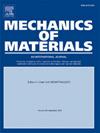Deformation mechanism and thermal conductivity of WS2/Ni heterostructure
IF 3.4
3区 材料科学
Q2 MATERIALS SCIENCE, MULTIDISCIPLINARY
引用次数: 0
Abstract
This study employs molecular dynamics (MD) simulations to construct WS2-coated nickel (Ni) substrates and investigate their tribological and thermal conductivity properties. The effects of varying scratching depths, speeds, and temperatures on the tribological performance were explored, alongside analyses of temperature differences, overall temperature, and model size on thermal conductivity using non-equilibrium MD (NEMD). Results reveal that WS2/Ni heterostructures exhibit self-repair mechanisms that mitigate surface damage during scratching, reducing friction coefficients compared to bare Ni substrates. The friction coefficient increased with deeper scratching due to atomic accumulation and extrusion, while higher scratching speeds maintained low friction levels, indicating robust lubrication. Furthermore, higher ambient temperatures reduced the friction coefficient. However, thermal conductivity was unaffected by temperature variation between hot and cold zones. Thermal conductivity increased with model size and decreased at elevated temperatures, exhibiting minimal anisotropy overall. These findings highlight the potential of WS2/Ni heterostructures for applications requiring high-performance lubrication and thermal management in sectors such as precision machinery and aerospace.
WS2/Ni异质结构的变形机理及导热性能
本研究采用分子动力学(MD)模拟构建了ws2涂层镍(Ni)衬底,并研究了其摩擦学和导热性能。研究了不同的刮擦深度、速度和温度对摩擦学性能的影响,并使用非平衡MD (NEMD)分析了温差、总温度和模型尺寸对导热系数的影响。结果表明,与裸露的Ni衬底相比,WS2/Ni异质结构具有自我修复机制,可以减轻刮擦过程中的表面损伤,降低摩擦系数。由于原子积累和挤压作用,摩擦系数随着刮擦深度的增加而增加,而较高的刮擦速度保持较低的摩擦水平,表明润滑性能良好。此外,较高的环境温度降低了摩擦系数。然而,热导率不受冷热区温度变化的影响。导热系数随模型尺寸增大而增大,在温度升高时减小,总体上表现出最小的各向异性。这些发现突出了WS2/Ni异质结构在精密机械和航空航天等领域需要高性能润滑和热管理的应用中的潜力。
本文章由计算机程序翻译,如有差异,请以英文原文为准。
求助全文
约1分钟内获得全文
求助全文
来源期刊

Mechanics of Materials
工程技术-材料科学:综合
CiteScore
7.60
自引率
5.10%
发文量
243
审稿时长
46 days
期刊介绍:
Mechanics of Materials is a forum for original scientific research on the flow, fracture, and general constitutive behavior of geophysical, geotechnical and technological materials, with balanced coverage of advanced technological and natural materials, with balanced coverage of theoretical, experimental, and field investigations. Of special concern are macroscopic predictions based on microscopic models, identification of microscopic structures from limited overall macroscopic data, experimental and field results that lead to fundamental understanding of the behavior of materials, and coordinated experimental and analytical investigations that culminate in theories with predictive quality.
 求助内容:
求助内容: 应助结果提醒方式:
应助结果提醒方式:


